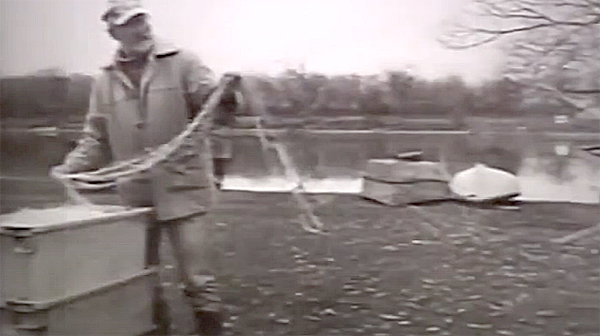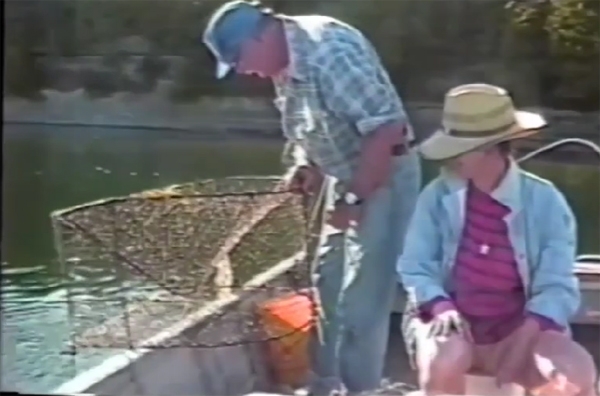County’s Vanishing Legacy of fishing, sailing and rum running
Administrator | Feb 26, 2023 | Comments 0
 By Sharon Harrison
By Sharon Harrison
The Vanishing Legacy is a deep and personal documentary of the final years of some of the men, women and children who made their living sailing, fishing and rum running on Prince Edward County’s rare, windswept and fragile South Shore.
Forming an important piece of Prince Edward County’s cultural heritage, it’s a celebration and acknowledgement of commercial fisher and fishing families captured by filmmaker Suzanne Pasternak.
Pasternak hosted the documentary as part of a virtual event hosted by the South Shore Joint Initiative (SSJI), in conjunction with County Museums Flashback February programming celebrating Ontario Heritage week.
The 1997 documentary, now 25 years old, a co-production with Kingston’s Cable 13, won a best documentary of the year award with Cogeco, which was then Cable 13 Kingston, notes Pasternak.
Based out of South Bay and Long Point, lake-faring families forged a unique maritime culture in these remote areas.
Moving to Prince Edward County in 1983, Pasternak, a filmmaker, musician, writer and photographer has spent more than 33 years collecting and documenting oral histories on the maritime history of eastern Ontario, much of which focuses especially on the South Shore.
She recounts how lucky she was to move to Long Point and the South Shore of Prince Edward County in 1988.
 “I was surrounded by a maritime community of wonderful fisherman, women and kids; a beautiful, beautiful culture that I realized was vanishing.”
“I was surrounded by a maritime community of wonderful fisherman, women and kids; a beautiful, beautiful culture that I realized was vanishing.”
“My rock is on that home-bound peninsula that juts out in the north-east end of Lake Ontario called Prince Edward County,” reflects Pasternak. “The eastern tip of Prince Edward is called Long Point, and it is the graveyard of the Great Lakes with its swirling currents and hidden shoals, and sudden wild wilds that have caused so many shipwrecks in the past.”
Armed with cassette players and cameras, photographs, video cameras and television crews, she began to document the final years of what she describes as a “beautiful culture”, where work on the project continues to this day.
“I have had the pleasure of working with Suzanne over the last couple of years conducting interviews and putting together her vast archive on the South Shore,” adds Amy Bodman, SSJI board member.
With guitar accompaniment, Pasternak sang few songs connected to those fishermen, as well as the rum running days, where the short documentary, Vanishing Legacy: Fishing, Sailing and Rum Running on Lake Ontario, followed.
 “This is the story of the vanishing legacy of my friends and neighbours, the last in the line to make their living off the waters of Lake Ontario,” began Pasternak.
“This is the story of the vanishing legacy of my friends and neighbours, the last in the line to make their living off the waters of Lake Ontario,” began Pasternak.
Gently strumming her guitar as she spoke, she explains how there was a time in Prince Edward County history when South Bay and the South Shore was the living heartbeat of crime in Canada.
“Those were the rum running days and the booze makers which hire the commercial fisherman of Prince Edward County, particularly Long Point, to transport in darkness across the lake to Oswego, New York, and Syracuse, smuggling booze for the booze makers.”
Exciting tales and fascinating adventures of a stranded ship off Main Duck Island with school children on board ensued, along with tales of unusual creatures found in the lake, fishy tales and real-life stories, including the struggles of being caught in a bad storm.
The documentary dove into some of the wondrous stories of County lake-faring families, where local commercial fisherman, some of whom have now passed on, shared thoughts on a changing industry, along with real-life accounts of their time at sea, an existence many inherited from generations before them.
“Have you ever heard a fisherman that couldn’t tell a story? I sat wide-eyed listening to these stories,” recalls Pasternak.
County commercial fisherman, Roxy Lancaster spoke to traditional fishing families, but also how unfortunate it was because the number of people to pass down that knowledge is now limited.
 “I learned the fishery from my father, and my mother’s family was fisherman as well, so I got the tradition,” said Lancaster. “The unfortunate part is a limited number of people to pass the knowledge down, there are a number of us in the industry right now that have no heir to pass it to.“
“I learned the fishery from my father, and my mother’s family was fisherman as well, so I got the tradition,” said Lancaster. “The unfortunate part is a limited number of people to pass the knowledge down, there are a number of us in the industry right now that have no heir to pass it to.“
Pasternak says the fisherman’s fathers, grandfathers, and great grandfathers fished these waters.
“As well, the knowledge of seamanship has been passed down from generation-to-generation; in the 1990s, there were few differences between the fisherman of today and the old ways of their ancestors.”
Lancaster describes the inextricable link between farming and fishing in the day, where he noted how most of the commercial fisherman at the time were part-time fisherman, his grandfather included.
“He had his own mixed farm and the fishing was actually for income; the farm was to feed the family and any extra they grew on the farm was also income, but the fishery on the Point here most of the farmers fished.”
Pasternak describes how for those people who lived their lives on the water, there has been a long tradition of search and rescue of other vessels in distress on the lake.
“More often than not, the commercial fishermen arrive on the scene well before either the Canadian or American coastguard -rescues at sea are almost a way of life for them,” she said.
“It never ceases to amaze me how calm and confident the fishermen remain in the face of howling gales and raging seas; I never met one of them who ever admitted to being afraid while in the midst of a storm at sea.”
Lancaster talks about the how the number of commercial fishing licences has declined since 1950, and is maybe down in the 20s now.
“It’s hard to believe how many people were licensed to fish at one time. It’s easy to think the number of fish in the lake has shrunk, but I find that a little bit hard to believe,” he says.
The late Howard Welbanks, a commercial fisherman based out of Amherst Island, said it was the end of a long tradition.
“It’s not good, at one time there was about 45 fisherman on the Main Ducks, and at the same time, I would say maybe 20 fisherman out of Point Traverse, same with Indian Point,” he said.
Lancaster also talks about how the weather determines their time on the lake, and how often they go out against the weather forecast.
“We listen to the forecast from the radio constantly and once we’ve heard the marine forecast, we generally take a look at the sky and watch the way the current boils at the harbour entrance,” Lancaster explains.
“How high the tide is at the harbour, what clouds are in the sky, what direction the wind is coming, you get the best forecast you can, then you extrapolate the whole thing, mixing it up, and you say, okay, my gut feeling is this -and it’s surprising how often we are right.”
He also describes an entertaining first encounter with a mud puppy, something the lake is full of he says, but something he had not seen before.
“I grew up around the fishery and it never ceases to amaze me the creatures that come out of this lake that I’ve never seen before.”
A question session followed with Pasternak, where it was apparent a lot of the audience has a special connection back to the fishing industry through family and ancestors.
The South Shore of Prince Edward County extends from Point Petre to Prince Edward Point, according to SSJIs definition, and includes one of the largest stretches of largely undeveloped shoreline on the north side of Lake Ontario.
“It is a wild place, home to tremendous biodiversity, diverse ecosystems, rural landscapes, and significant maritime history that include a commercial fishery that is over 200 years old,” Bodman explained.
“At one point, it was one of the largest freshwater fisheries in the world.”
The SSJI (ssji.ca) is a group of partner organizations and members whose mission is to educate and advocate for the protection, preservation and restoration of the South Shore lands and waters.
“It has been a real honour to meet Suzanne and to meet the fishing families that hold so much knowledge about our cultural history and about the waters that surround us,“ said Bodman.
Working with the SSJI, Pasternak and Bodman have carried this work on and continue to interview and document the lives and stories of commercial County fisher people.
Bodman said the plan is to publish a book in the next year which will be an illustrated oral history of the South Shore commercial fishery.
Filed Under: Featured Articles
About the Author:































